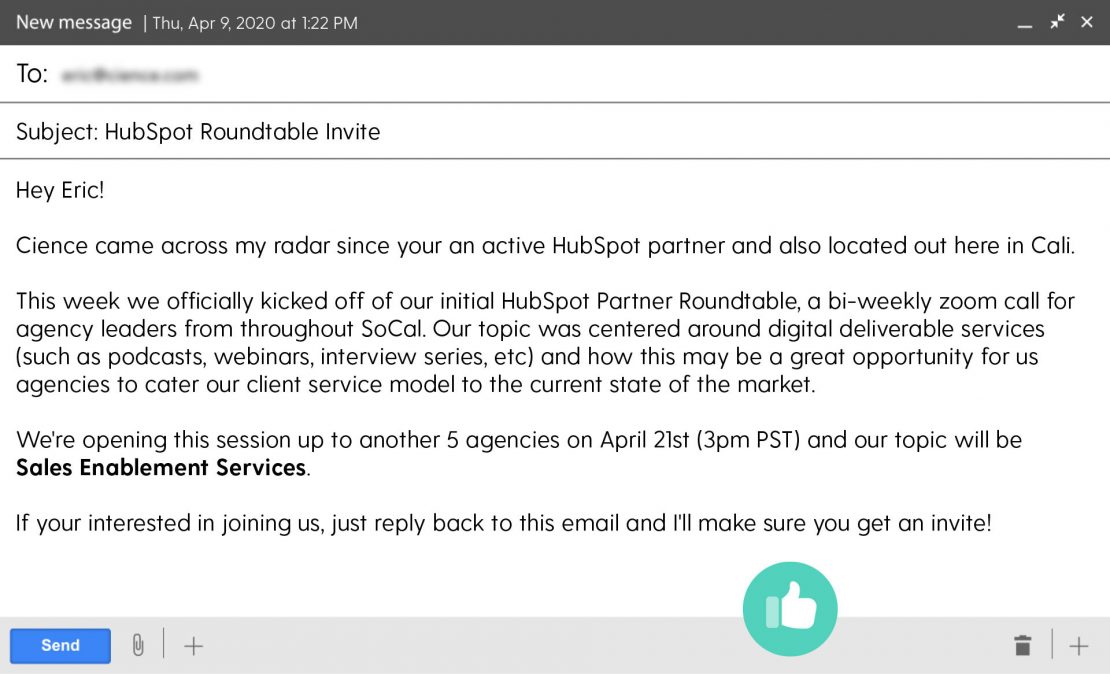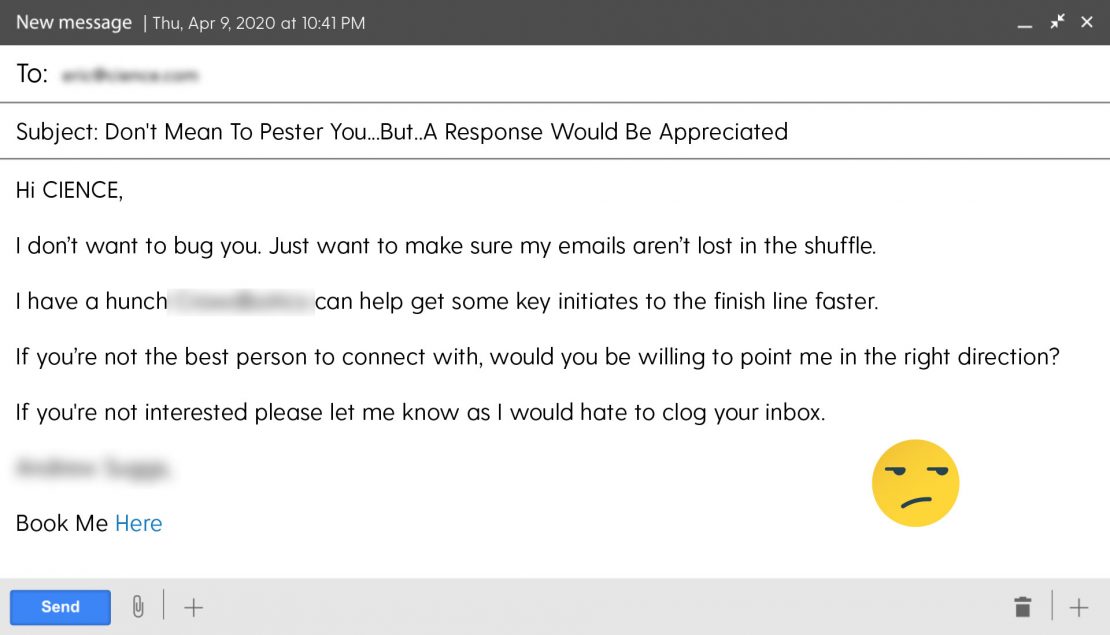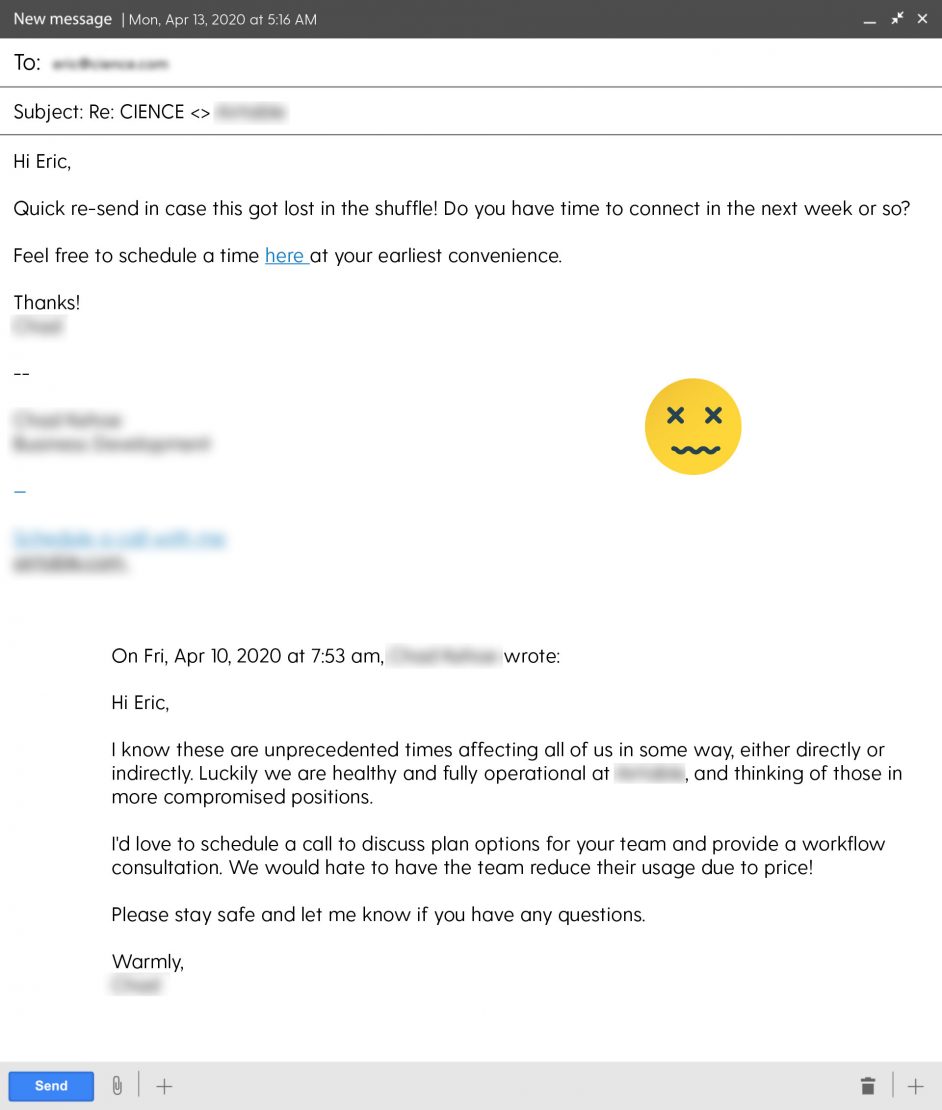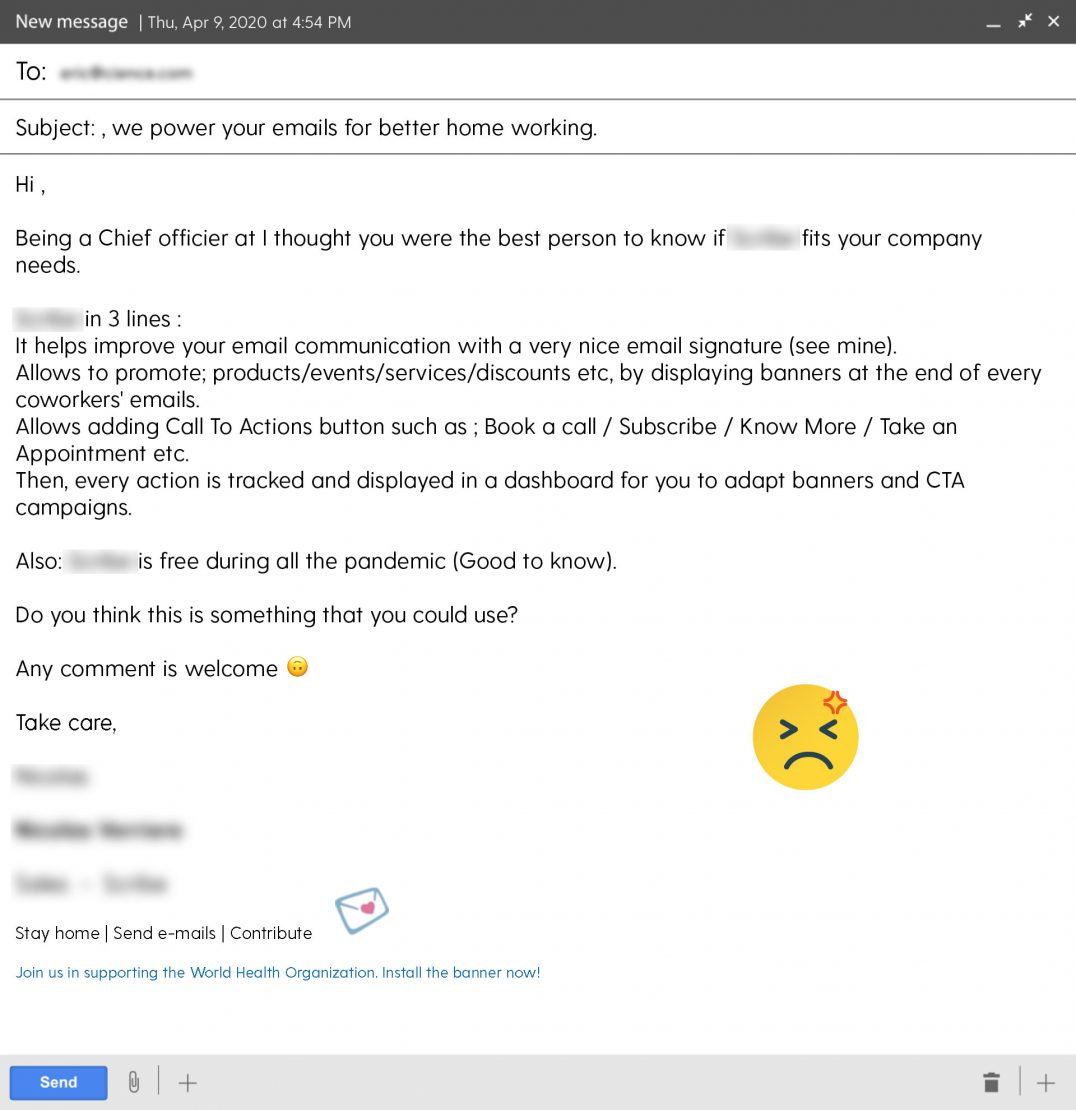Outbound Emailing in Times of Uncertainty – The Best and Worst of April 2020
Before we dive into the highlights and lowlights of the Good, Bad and Ugly cold emails from Q1, let us take a collective deep breath. Hold and exhale slowly.
In the grand scheme of life, yes, cold emails take a backseat to our safety and health. But they can introduce hospitals to systems that can help save lives by generating full health histories for every patient. For example, one of our clients has created a new technology to unify patient records across the nation and ultimately create a clinically integrated network, at last. Many hospitals wouldn’t know about this game-changing tech without good old-fashioned outbound.
And in a more general business sense, it has been a whirlwind start to 2020. Okay, maybe closer to a whiplash. We came into the year with a roaring economy, bullish outlooks on the future, a smattering of contraction warnings. We were buried by what seemed like weekly stock market record highs, and the lowest unemployment rates in history.
And while all that has changed – as business owners, sales leaders, marketing magicians, and content evangelists – we know the show must go on… and business must continue. It’s what we do; our raison d’etre.
Nearly all B2B marketers use email to distribute content (93% to be exact). With shelter-in-place, there are now fewer Go To Market channels and smaller budgets (influencer marketing may never rebound either), so email and phone channels will be more critical to sustaining business and angling for growth through the next couple of years.
At CIENCE, we’ve sent hundreds of thousands of emails on behalf of clients and for growing our business. We’re always looking for inspiration, as well as what not to do when it comes to cold emailing. So these are a few things we took notice of this last month (that took a year).
The Best Email
We begin with the best email because it checks all the boxes for turning an uncertain situation into an opportunity to build diverse relationships.
When you read this email, keep in mind that this is sent to our CMO from a Business Development Rep.

Can you guess what response this elicited? A simple enthusiastic reply: “Well played. Count me in.”
In the world of outbound, that kind of authentic prospect response is the thing of dreams. So why did this email work so well?
First, the opener is extremely prospect focused, and the first sentence brings the prospect to the sender’s side of the table – a HubSpot partner and located in Cali.
Second, there’s no sales pitch. Instead of saying “we’re here to help you in these uncertain times” (which we all know is code for our product or service can give you a little peace of mind while you’re stressed out), the sender offered support through a Partner Roundtable as a place where agencies can help each other “cater our client service model to the current state of the market.”
It is better to be helpful than to say you’re here to help. Provide value and prospects will respond accordingly.
There wasn’t a direct mention of coronavirus or health wishes. Instead, they played up the exclusivity angle. By opening up the session to only 5 more agencies, the Fear of Missing Out caused the desired effect: An easy YES!
What about the typos?
Did you catch them in the Best Email? If you didn’t, don’t feel bad. Neither did we on first read. But look closely and you’ll see that the author used the wrong your. Not just once, but twice the author used “your” when proper grammar would be the contraction for you are – you’re.
Did it reflect poorly on the sender or their company and brand? Not in this case.
But why not? Because this email was helpful and human. Humans aren’t perfect; we’re fallible. We’re not advocating for people to start sending us horribly written emails that disregard the rules of English.
Don’t sacrifice what is good in the pursuit of perfection.
As a campaign strategist and email marketer with CIENCE, I’ve personally worked on over 120 accounts and north of 300 campaigns. I can tell you that some of our best performing emails have had a couple of typos or grammatically irregular sentences. Some were by design. Like the perfectly placed sentence fragment. On the other hand, some simply fell through the cracks.
The lesson: even the best writers and Sales Development Reps make mistakes. Don’t kill great in the pursuit of perfection.
The Bad
The goal of outbound marketing (really, the goal of any marketing) is to persuade qualified prospects to take an initial meeting. The best cold emails tease out just enough information that the prospect feels compelled to take a meeting with you.
That said, it’s a fine line between being intriguing and being unrecognizable… These cold emails are bad because there is no hint whatsoever at what they’re even talking about, let alone how they can help. With a deft hand, a ‘nothingness’ approach can make a positive response irresistible! But not so with these…

Questions to ask the sender before they try again:
- What key initiatives can you help get to the finish line?
- Always a fan of making sure you’re speaking with a decision maker, but how can the recipient help if there’s ZERO information?
- Spend less time apologizing for “clogging inboxes” and use those words to at least hint at value.
To be fair, this email sender has a knack for saying the same thing in different ways:
“Don’t mean to pester you” = “Don’t want to bug you” = “would hate to clog your inbox” All of these “tricks” make a prospect think, ‘you really are bothering me.’
 If you thought these were from the same company, I don’t blame you. They’re equally obtuse, generalized beyond the point of recognition.
If you thought these were from the same company, I don’t blame you. They’re equally obtuse, generalized beyond the point of recognition. Another issue is the feigned concern attributed to COVID-19 in the first paragraph – it comes off self-interested as the sender says “Luckily we are healthy and fully operational at [ACME Company], and thinking of those in more compromised positions.”
There was a chance for the sender to connect the operational into workflows and turn their “concern” outward towards their prospects. However, we’ll never know because we don’t know what this company does to improve workflows.
Side Note: One of my greatest pet peeves lately with all this remote work is “workflow”: Every solution improves “workflow.” It has officially taken its place in the buzzword hall-of-fame, alongside ‘digital transformation,’ ‘move the needle,’ and ‘disruptive.’
The Ugly
The month’s worst example of cold email isn’t the worst because of lack of trying, but it does highlight why the strategies already discussed require a deft touch and strongly executed strategy.
Take a look (and try not to cringe):

The subject line is the first signal of a coming disaster. It looks like there was supposed to be a token that was never properly inserted. We see the missing token again in the salutation line of the email body. These mistakes are almost always email killers, even if the rest of the email is helpful.
If you’re having trouble with automating and personalizing emails at scale, it could be a sign of an unhealthy Customer Relationship Management (CRM) platform. Reach out to us if you’d like to discuss best practices for implementing and maintaining a healthy CRM.
It seems like this sender took our typo suggestion and ran away with it. This is NOT an example of innocent grammatical mistakes, and the lack of proper spelling, punctuation and bullet points are enough for any recipient to mark SPAM and trash it.
There are many content and structure faux pas to hone in on here, but the email comes off as awfully tone deaf of the present moment.
How many businesses in April 2020 have email signatures as a must-have need to spend budget on right now? It’s fair to assume next to nil. That’s not the issue, the issue is assuming that this is a present and clear challenge.
A better tack might be to acknowledge that this probably isn’t a top priority, but we’d love to share with you how you can standardize effective signatures across your company’s entire workforce (a thorn in many CEO’s sides).
The Sign Off
It’s not an easy time to email, but if it were easy then everyone would be successful at landing appointments through the outbound channel. If you’re looking for some additional tips to get more leads from outbound marketing, check out our guide to writing better cold emails, or book a meeting with our B2B Outbound Specialist.
A Few (Related) Sales Posts
 Read full post: The Good, The Bad, The Ugly, and Now Introducing… The Bugly
Read full post: The Good, The Bad, The Ugly, and Now Introducing… The Bugly
The Good, The Bad, The Ugly, and Now Introducing… The Bugly
 Featured image: Good and bad emails of October - Read full post: Good, Bad & Ugly of Cold Emails
Featured image: Good and bad emails of October - Read full post: Good, Bad & Ugly of Cold Emails
Good, Bad & Ugly of Cold Emails
 Read full post: 7 Best and Worst Cold Email Opening Lines
Read full post: 7 Best and Worst Cold Email Opening Lines
